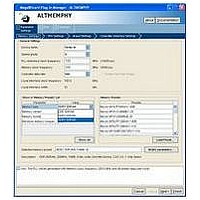IPR-HPMCII Altera, IPR-HPMCII Datasheet - Page 66

IPR-HPMCII
Manufacturer Part Number
IPR-HPMCII
Description
IP CORE Renewal Of IP-HPMCII
Manufacturer
Altera
Datasheet
1.IP-HPMCII.pdf
(176 pages)
Specifications of IPR-HPMCII
Software Application
IP CORE, Memory Controllers, SDRAM
Supported Families
Arria II GX, HardCopy III, Stratix III, Stratix IV
Core Architecture
FPGA
Core Sub-architecture
Arria, HardCopy, Stratix
Rohs Compliant
NA
Lead Free Status / RoHS Status
na
- Current page: 66 of 176
- Download datasheet (4Mb)
5–14
Table 5–1. DDR3 SDRAM Clocking in Arria II GX Devices (Part 1 of 2)
External Memory Interface Handbook Volume 3
Section II. DDR3 SDRAM Controller with ALTMEMPHY IP User Guide
phy_clk_1x
and
aux_half_rate_clk
mem_clk_2x
and
aux_full_rate_clk
mem_clk_1x
write_clk_2x
Clock Name
f
1
(1)
The input clock to the PLL does not have any other fan-out to the PHY, so you do not
have to use a global clock resource for the path between the clock input pin to the
PLL. You must use the PLL located in the same device quadrant or side as the
memory interface and the corresponding clock input pin for that PLL, to ensure
optimal performance and accurate timing results from the Quartus II software.
You must choose a PLL and PLL input clock pin that are located on the same side of
the device as the memory interface to ensure minimal jitter. Also, ensure that the input
clock to the PLL is stable before the PLL locks. If not, you must perform a manual PLL
reset (by driving the global_reset_n signal low) and relock the PLL to ensure that the
phase relationship between all PLL outputs is properly set.
If the design cascades PLLs, the source (upstream) PLL should have a low-bandwidth
setting, and the destination (downstream) PLL should have a high-bandwidth setting.
Adjacent PLLs cascading is recommended to reduce clock jitter.
Cross-device cascading PLLs are only allowed in Stratix III devices with the following
conditions:
■
■
For more information about the VCO frequency range and the available phase shifts,
refer to the Clock Networks and PLLs chapter in the respective device family handbook.
Table 5–1
Postscale
Counter
Upstream PLL: 0.59 MHz =< upstream PLL bandwidth < 1 MHz. The upstream
PLL should use the With No Compensation operation mode.
Downstream PLL: downstream PLL bandwidth > 2 MHz.
C0
C1
C2
C3
shows the clock outputs that Arria II GX devices use.
(Degrees)
Phase
–90°
0°
0°
0°
Clock Rate
Half-Rate
Half-Rate
Full-Rate
Full-Rate
Network Type
Global
Global
Global
Global
Clock
Chapter 5: Functional Description—ALTMEMPHY
The only clocks parameterizable for
the ALTMEMPHY megafunction.
These clocks also feed into a
divider circuit to provide the PLL
scan_clk signal (for
reconfiguration) that must be lower
than 100 MHz.
This clock is for clocking DQS and
as a reference clock for the
memory devices.
This clock is for clocking DQS and
as a reference clock for the
memory devices.
This clock is for clocking the data
out of the DDR I/O (DDIO) pins in
advance of the DQS strobe (or
equivalent). As a result, its phase
leads that of the mem_clk_2x by
90°.
December 2010 Altera Corporation
Notes
Block Description
Related parts for IPR-HPMCII
Image
Part Number
Description
Manufacturer
Datasheet
Request
R

Part Number:
Description:
IP NIOS II MEGACORE RENEW
Manufacturer:
Altera
Datasheet:

Part Number:
Description:
IP CORE Renewal Of IP-XAUIPCS
Manufacturer:
Altera
Datasheet:

Part Number:
Description:
IP CORE Renewal Of IP-10GETHERNET
Manufacturer:
Altera
Datasheet:

Part Number:
Description:
IP CORE Renewal Of IP-ASI
Manufacturer:
Altera
Datasheet:

Part Number:
Description:
IP CORE Renewal Of IP-CIC
Manufacturer:
Altera
Datasheet:

Part Number:
Description:
IP CORE Renewal Of IP-CRC
Manufacturer:
Altera
Datasheet:

Part Number:
Description:
IP CORE Renewal Of IP-ED8B10B
Manufacturer:
Altera
Datasheet:

Part Number:
Description:
CPLD, EP610 Family, ECMOS Process, 300 Gates, 16 Macro Cells, 16 Reg., 16 User I/Os, 5V Supply, 35 Speed Grade, 24DIP
Manufacturer:
Altera Corporation
Datasheet:

Part Number:
Description:
CPLD, EP610 Family, ECMOS Process, 300 Gates, 16 Macro Cells, 16 Reg., 16 User I/Os, 5V Supply, 15 Speed Grade, 24DIP
Manufacturer:
Altera Corporation
Datasheet:

Part Number:
Description:
Manufacturer:
Altera Corporation
Datasheet:










